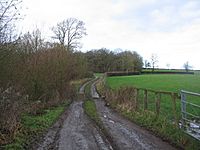Postlebury Wood facts for kids
| Site of Special Scientific Interest | |
 |
|
| Area of Search | Somerset |
|---|---|
| Coordinates | 51°11′08″N 2°22′24″W / 51.18563°N 2.37339°W |
| Interest | Biological |
| Area | 87 hectares (0.87 km2; 0.34 sq mi) |
| Notification | 1987 |
Postlebury Wood is a special forest in Somerset, England. It covers about 87 hectares (that's like 215 football fields!). This wood is so important for nature that it was named a Site of Special Scientific Interest (SSSI) in 1987. This means it's a protected area because of its amazing plants and animals.
Contents
History of Postlebury Wood
Postlebury Wood has a very long history. People first wrote about this woodland way back in 1182! That's over 800 years ago. Soon after, it became part of the Royal Forest of Selwood. In the past, people used the wood for 'coppicing'. This is a way of cutting trees to let them regrow from the stump. They also used the wood to make charcoal. Even with all that activity, much of the wood remains untouched today.
Amazing Plants of the Wood
This forest is home to many different kinds of plants. The main trees you'll find here are Oak (Quercus robur), Ash (Fraxinus excelsior), and Hazel (Corylus avellana).
Ground Plants
The plants growing on the forest floor are also very special. You can see beautiful bluebells (Hyacinthoides non-scripta) covering the ground. Other common plants include Bracken (Pteridium aquilinum), Foxglove (Digitalis purpurea), and Wood Sorrel (Oxalis acetosella).
Rare and Special Flowers
Postlebury Wood is also home to some rare and interesting flowers. Keep an eye out for Solomon's Seal (Polygonatum multiflorum). You might also spot different kinds of orchids, like the Greater Butterfly Orchid (Platanthera chlorantha) and the Bird's Nest Orchid (Neottia nidus-avis). The Broad-leaved Helleborine (Epipactis helleborine) and the Autumn Crocus (Colchicum autumnale) also grow here.
Unique Primroses
One of the most amazing things about Postlebury Wood is its special Primroses. These primroses are unique because they can fertilize themselves. Most primroses need pollen from another plant to make seeds. These special primroses are found in only one other area outside of south-east Somerset. Scientists are very interested in these plants. They help them learn more about plant genetics and how plants reproduce.

